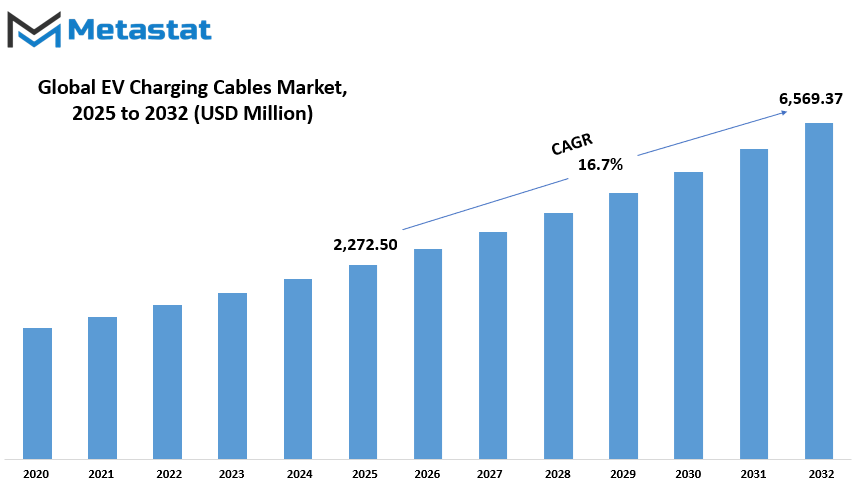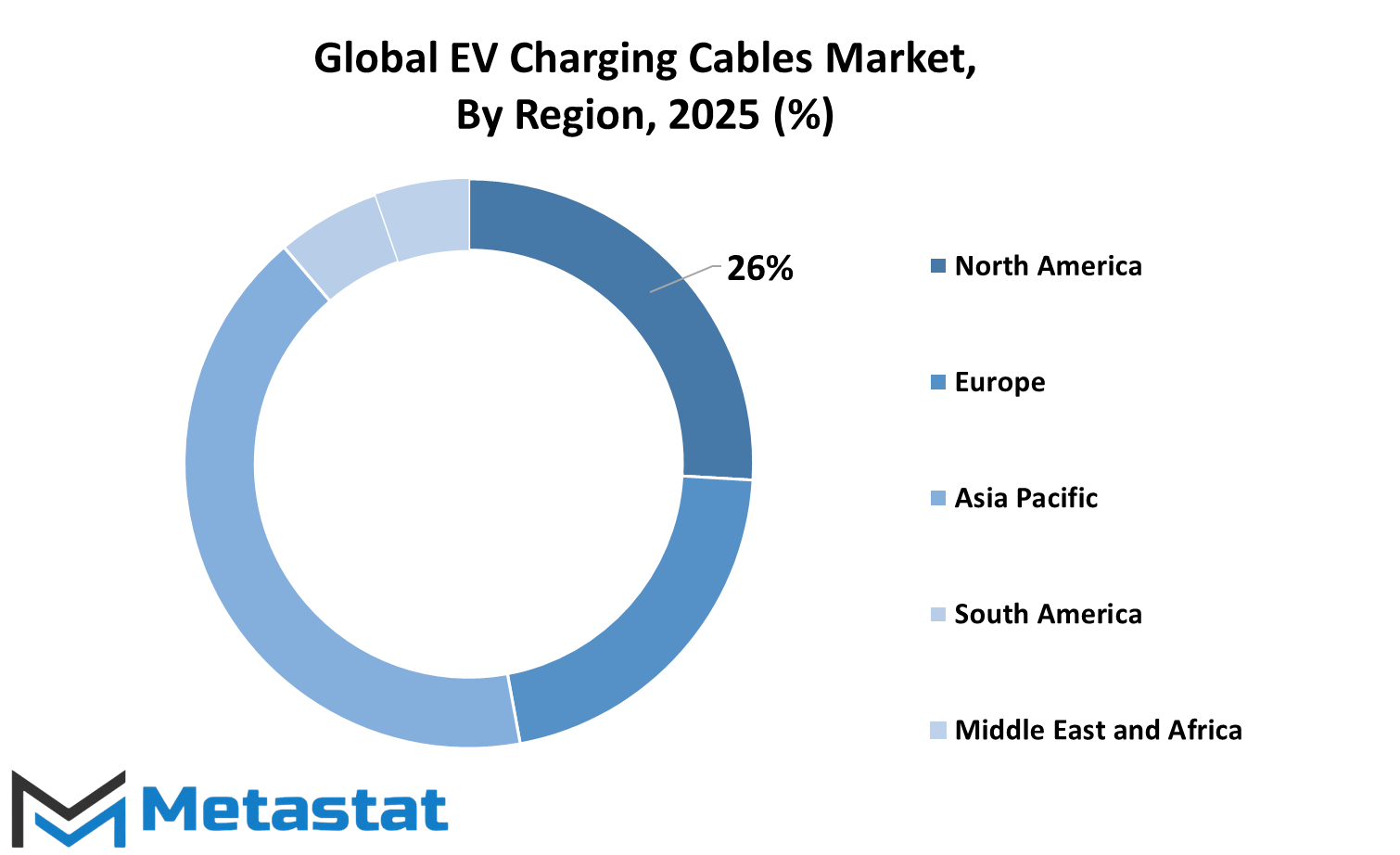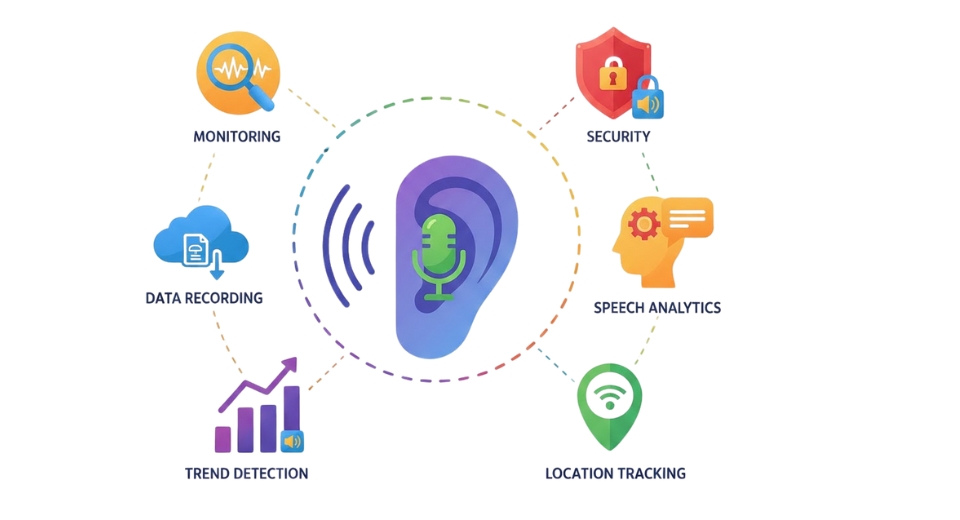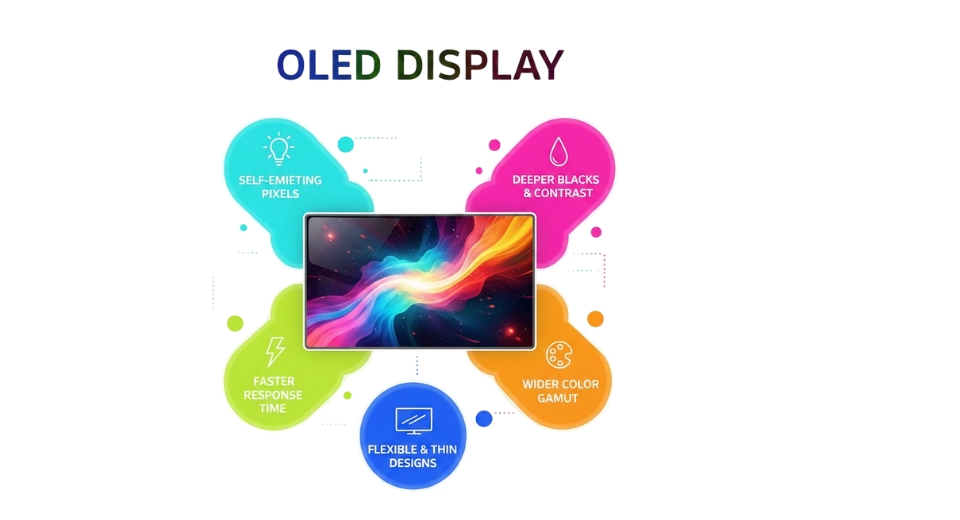MARKET OVERVIEW
The Global EV Charging Cables Market represents one of the most imperative sectors in the electric vehicle industry, acting as the infrastructure backbone in supporting the shift from internal combustion engine vehicles to sustainable electric transportation. This market is focused on the production, distribution, and further development of specific, high-end cables that could connect EVs with charging stations. These cables ensure efficient and safe transfer of electricity with zero lag between the source of power and the vehicle. With the progression of the world toward clean energy solutions, the importance of EV charging cables will only increase.
It includes new designs, materials, and improvements in cable performance. Charging cables are designed to support different charging speeds, from slow to ultra-fast, and must meet global safety and efficiency standards. Their design must also accommodate varying environmental conditions, ensuring durability in extreme temperatures and resistance to wear and tear from prolonged use. In addition, charging cables can include advanced technologies, smart charging systems and connectivity, so the charging processes can be followed, and further user convenience enhanced.
Geographically, the market caters to the diversified needs of the regions with differing levels of EV adoption, regulatory frameworks, and technological advancement. While developed nations with well-entrenched EV infrastructure demand cables for high-powered charging networks, emerging economies focus on cost-effective solutions to expand access to EVs. The global diversity requires manufacturers to devise flexible strategies to fill the specific gaps of various markets. The industry is also characterized by collaborations between cable manufacturers, automotive companies, and energy providers.
These partnerships are designed to create standardized solutions that ensure compatibility across various EV models and charging systems. As such, the market is not limited to standalone manufacturers but includes an ecosystem of stakeholders working together to facilitate the widespread adoption of EVs. Regulatory policies and initiatives supporting EV infrastructure development also shape the market’s trajectory, fostering innovation and investment in charging technologies. In the coming years, the Global EV Charging Cables market will witness continuous advancements in materials science, leading to lighter, more flexible, and energy-efficient cable designs.
Further impetus in the market would come from renewable sources of energy since the charging cable will be built with integration of solar and wind power systems. Also, there would be more urbanization with the development of smart cities. That would result in a surge for compact portable charging cables. In summary, Global EV Charging Cables represents that critical link of the EV ecosystem whose growth will go hand-in-hand with technological innovation, regional diversity, and a global push for a cleaner, greener future. Its development will be fraught with challenges on efficiency, safety, and accessibility, which the market will play a part in building the future of modern transportation.
Global EV Charging Cables market is estimated to reach $6,569.37 Million by 2032; growing at a CAGR of 16.7% from 2025 to 2032.

GROWTH FACTORS
The global EV industry has registered an upward trajectory with the continuous increasing number of people and establishments turning towards more cleaner and greener modes of transport. Critical to this boom is the worldwide EV charging cables market. Aiding the popularization of electric vehicles by enabling their very usage, a good part of this market is through charging infrastructure that makes electric vehicles useful for transportation needs. With increasing demand for electric vehicles, there also comes the necessity for charging cables that are efficient, reliable, and accessible. The main drivers of the global EV charging cables market are a result of increased demand for electric vehicles, the imposition of stringent environmental regulations, and development in charging technology.
With reduced carbon emissions as an agenda from the government and private bodies, electric vehicles are more of a compulsion than an option. With the increasing numbers of consumers adopting this change, there is also an increased need for compatible charging cables. Another reason is the faster charging technology that has emerged to enable a quicker and efficient charge on vehicles. The demand for specialized cables increases further with such technologies. This change towards renewable energy sources supports the market’s growth as well.
As more charging stations begin to adopt solar and wind energy, there is a significant push to develop cables that can work with these energy sources in a sustainable way. The integration of smart charging systems, which can manage energy use based on availability and price, is also increasing the need for more advanced charging cables. These innovations make it easier for individuals and businesses to charge their electric vehicles without wasting energy or resources. However, despite the many factors contributing to market growth, there are challenges that could hinder the progress of the global EV charging cables market.
The high cost of installing charging stations, especially in remote or less developed areas, can limit access to EV charging infrastructure. However, the lack of standardization in charging cable designs and connectors has brought about compatibility problems for manufacturers as well as consumers. This may eventually result in the lack of confidence in the technology as well as in the deployment of charging stations. However, all hope is not lost. The future prospects for the global EV charging cables market look bright.
As this industry overcomes its challenges, there will be a rise in new opportunities. An example is the creation of new market opportunities for charging stations and cables with the increasing urban infrastructure as well as pressure to adopt more EVs into commercial fleets. Additionally, improved wireless charging technologies and advancements in materials science should lead to improved and better cable designs that are more efficient. As the world becomes increasingly focused on providing energy solutions that are sustainable, the global EV charging cables market will most definitely expand and continue to thrive in the upcoming years.
MARKET SEGMENTATION
By Charging Level
The Global EV Charging Cables market is expected to experience significant growth as the world shifts toward cleaner sources of energy and sustainable transport. In fact, electric vehicles will soon take over the future of mobility, driving inspiration in the light of improved technology, governmental efforts to reduce carbon footprint through stringent emissions policy, and awareness among consumers regarding the concept of adopting clean transportation. This has further created an increasing demand for effective and trustworthy charging infrastructure. Charging cables play an important role in the utilization of electric vehicles, creating a seamless operation of electric vehicles.
The Global EV Charging Cables market is segmented based on charging levels, including Level 1, Level 2, and Level 3. Each of the levels provides different charging speeds and power outputs, designed to cater to varying use cases. Level 1 charging is also known as slow charging, and it’s the most widely used in residences. It can be charged overnight. Level 2 is considered a more advanced option and gives faster charging rates. It’s widely used both in residential and public spaces and serves as a perfect balance between convenience and efficiency. Level 3, or DC fast charging, is the fastest charging option, mainly for commercial and high-traffic areas where turnaround times are critical. This segment alone accounted for $1,198.03 million, which is a significant contribution to the market.
The future of the Global EV Charging Cables market is innovation and the increasing adoption of high-performance cables that support ultra-fast charging technologies. As electric vehicles become more mainstream, the demand for durable, heat-resistant, and cost-effective charging cables is expected to grow exponentially. Manufacturers are focusing on improving cable designs to enhance safety and ensure compatibility with various charging systems globally. Additionally, the integration of smart charging capabilities is anticipated to redefine the charging experience, allowing users to monitor and control the process remotely.
The growing demand for electric vehicles in North America, Europe, and Asia-Pacific adds more fuel to the growth of the Global EV Charging Cables market. Governments around the world are investing in charging infrastructure, with subsidies and tax incentives offered to encourage electric vehicle usage. Considering the role of technology in the light of these factors, the market is in a position where it will achieve sustainable growth through the next few years with a robust commitment to a greener future. With accelerating shifts toward electrification, the Global EV Charging Cables market will remain a cornerstone of this transformative movement.
By Cable Type
The Global EV Charging Cables market is expected to rise dramatically with increasing electric vehicle (EV) demand and the worldwide movement toward green transport. With advancements in technology, EVs have brought into the picture a critical requirement of efficient and reliable charging infrastructure. One of the most crucial elements of this infrastructure is the charging cable that connects the EV to charging stations, enabling the efficient and smooth transfer of power. With increasing adoption worldwide, the development of advanced charging cables is vital in future electric vehicles.
The market for EV charging cables is divided on the basis of cable type into normal charging cables, high-power charging cables (HPC), and liquid-cooled high-power charging cables. The successive segment serves the need of different types of consumers and industries. Normal charging cables are built for daily applications, allowing sufficient power levels for charging at home and the workplace. Standard charging stations use these cables, though they are most commonly applied by private owners of electric vehicles. As the demand for faster charging increases, high-power charging cables have become an essential alternative to the former. High-power cables provide rapid charging; for that reason, they have become an absolute necessity for commercial charging stations and long-distance travel corridors. The most innovative product in the market currently is liquid-cooled high-power charging cable.
These cables solve the challenge of heat generation in high-speed charging. Using liquid cooling technology, they maintain the optimal temperature of the cable to ensure safety and efficiency even in long periods of use. It is expected to be one of the technologies that will play a significant role in ultra-fast charging networks, which are considered key for the successful widespread adoption of EVs. Liquid-cooled cables will be the biggest beneficiary of such changes in the future, as most EV manufacturers and infrastructure developers would focus on fast charging.
The Global EV Charging Cables market will experience significant growth as governments and private businesses continue to invest in charging infrastructure. Adoption of EVs will increase largely due to increasing rules on emissions as well as a growing awareness among consumers concerning environmental sustainability. Manufacturers of the charging cables, therefore, are innovating their products for durability and user-friendliness while responding to the requirements of the industry.
This market is set to play a significant role in the future of transportation, forming the foundation for a cleaner and more connected world. Advancements in cable technology and increasing collaboration across industries will ensure that the Global EV Charging Cables market remains at the forefront of the global transition toward electric mobility.
By Length
As adoption of electric vehicles (EVs) is witnessing growth across the world, so too the Global EV Charging Cables market is gaining traction gradually. The use of sustainable energy solutions by the people and various industries has emerged as a fundamental requirement for developing efficient and reliable charging infrastructure. In this chain, EV charging cables are at the core that ensures the effective transfer of energy from charging stations to vehicles. These cables are designed to meet the ever-growing demands of EV users who require faster, more dependable, and safe solutions to keep their vehicles charged and ready for use.
One notable way the market is categorized is by the length of the charging cables, which greatly influences their utility and application. The cables which are less than 5 meters in length can be used where the charging station is placed within a residential range or compact range of the vehicle. Those who have specific home chargers or reside in a space-crunchy environment will find the cables handy for everyday use. Excess cable management is not their problem, which makes them great for personal charging.
Instead, public charging stations or commercial applications frequently make use of 6 to 10 meters long cables. These medium-range cable sizes find a balance between accessibility and manageable lengths for a broader variety of vehicles and parking provisions. With further infrastructure development and expansion in urban areas regarding EV, there shall be continued demand for such cables. Flexible Cables. It is flexible. This means a driver can access his vehicle easily because the cables may not require complete alignment with the charging point.
For bigger establishments, such as fleet depots or specialized charging hubs, cable lengths over 10 meters in length are necessary for accommodating diverse parking scenarios and large vehicles, including buses or delivery vans. As electrification transitions from personal cars to public transit and commercial fleets, the volume of such cables is expected to rise. Being able to reliably charge in layouts that are even more complex than what the industry has traditionally seen, this is a piece of the infrastructure puzzle that the future will continue to build into.
The global EV charging cable market is expanding as EV use increases and the world's nations promote cleaner forms of transportation. But, the development focus will lie on designing long-lasting, efficient and adaptive cables meeting changing demands. Its future would be in line with global gradual shift to sustainability with its value further defining a greener future. Innovations continue to propel the market into a critical phase where support toward rapid electric mobility change appears increasingly imminent.
By Application
The Global EV Charging Cables market is on the forefront of a new-looking transportation world since electric vehicles (EVs) will continue to gain popularity around the globe. Progress in cleaner energy and sustainable practices have meant significant strides in EV technology, wherein charging infrastructure has become an essential aspect of this progress. A charging cable serves as an essential component of this system since it enables efficient energy transfer to EVs. Studying the market through the two major applications, Public Charging and Private Charging, it clearly shows how each of these categories contributes to industry growth and changes.
Public charging stations are supposed to be driving a significant majority of the Global EV Charging Cables market. As governments as well as private organizations invest substantially in charging networks to support ever-growing adoption of EVs, the demand for such durable and efficient cables will also continue to soar. These public stations are sometimes the lifeline for users who heavily rely on convenient facilities in case longer journeys are undertaken. On the other hand, an increased demand for faster and reliable charging solutions has led to innovations in cable technology, which is now able to carry higher voltages while keeping users safe.
As urban areas expand and traffic congestion becomes a growing concern, more public charging stations will likely emerge, further solidifying the role of advanced cables in supporting the transition to electric mobility. Private charging solutions are equally vital in shaping the Global EV Charging Cables market. Many EV owners prefer the convenience of charging their vehicles at home or in private spaces. This section needs the kind of cable that is easy to use, weather-resistant, and suitable for as many vehicle models as possible.
With growing EV ownership, private charging infrastructure will gain massive demand. Homeowners and firms will spur investments in bespoke solutions, further diversifying the market. The integration of smart charging technologies, which include such technologies as automated monitoring systems, is poised to further enhance the efficiency of private charging setups and provide additional opportunities for growth in this sector.
With technological advancements and growing concerns toward sustainability, the future of the Global EV Charging Cables market is bright. Public and private charging applications are going to cater to the requirements of a fast-growing user base of EVs, leading the way toward a cleaner and a more connected transportation ecosystem. The growth in the automotive industry not only represents a future but also leads toward a greener future.
|
Forecast Period |
2025-2032 |
|
Market Size in 2025 |
$2,272.50 million |
|
Market Size by 2032 |
$6,569.37 Million |
|
Growth Rate from 2024 to 2031 |
16.7% |
|
Base Year |
2024 |
|
Regions Covered |
North America, Europe, Asia-Pacific, South America, Middle East & Africa |
REGIONAL ANALYSIS
The global EV charging cables market is witnessing substantial growth, driven by the increasing adoption of electric vehicles and the need for robust charging infrastructure worldwide. Regional variations play a significant role in shaping this market, with each geographical area contributing uniquely to its expansion. In North America, the leading players are in the United States, Canada, and Mexico; such a well-developed automotive market along with governments taking initiatives on clean energy propel the region. Carbon emission has been a cause of concern across the region and, henceforth, investments are increasing in building more EV charging infrastructure, hence, driving more demand for EV charging cables in the region.
The UK, Germany, France, and Italy play an important role in the overall market of the region. For some time now, Europe has led the world in embracing renewable energy and electric mobility with strong regulations and subsidies for electric vehicles. Focus on advanced charging technology and public-private partnerships are driving the region's pursuit for efficient charging solutions. With this expansion of the charging network, there is also an increasing requirement for high-quality and high-performance charging cables to keep up.
Asia-Pacific region is growing as a global dominant force for EV charging cables, propelled by rapid industrialization and urbanization. In the Asia-Pacific region, countries like China, India, Japan, and South Korea are crucial for this growth as governments encourage the use of electric vehicles with incentives and support for infrastructure development. China stands alone at the top in terms of EV sales and production globally and, hence, is an essential market for charging cables. The Asia-Pacific region is expected to be the region that will change the face of this market as it expands urban areas and increases consumer demand for sustainable transportation.
South America, including countries such as Brazil and Argentina, is slowly adopting the change to electric mobility. Although the adoption rate is still lagging behind other regions, increasing environmental concerns and government initiatives are expected to drive demand for EV charging infrastructure, including cables. The Middle East & Africa are also just starting to look into opportunities in the EV sector, with South Africa, Egypt, and the GCC nations taking an interest in developing their charging networks.
Coming years will shape this global market with regional dynamics of a collective trajectory for the future of EV charging cables. Technological advancements and policy supports will be conducive to making sure that this market keeps changing as per the demands of the world's various regions.

COMPETITIVE PLAYERS
The Global EV Charging Cables Market is rapidly gaining importance because the world is moving towards a cleaner and sustainable source of energy. As people embrace electric vehicles, the market for charging infrastructures, high-quality charging cables included, would increase exponentially. Technological advances and government policies focused on reducing carbon emissions are accelerating growth in this industry, besides increased consumer consciousness of the electric mobility benefits. It therefore reflects a worldwide commitment to sustainability but also speaks to the significance of supportive technologies such as charging cables in accelerating the adoption of more EVs in the market.
The competition between the players within the market is intense, and several major market players constantly innovate to seek a competitive edge. Companies such as Schneider Electric, BESEN International Group, Leoni AG, and TE Connectivity are making all the right noises in terms of advanced, rugged, and efficient charging cable solutions. Their effort is towards speedy charging, robust safety features, and meeting different consumer and commercial operators' requirements. Companies like Leviton Manufacturing Co., Inc., Eaton Corporation, as well as ChargePoint, Inc. have innovated friendly price solutions which mitigate the above problems encountered in embracing such vehicles.
Further to the dynamism of the market, companies such as Phoenix Contact, Dyden Corporation, and Coroplast are targeting the integration of cutting-edge technologies into their products. For example, innovations in lightweight materials, higher conductivity, and temperature resistance are going to redefine the design and manufacturing of charging cables. Volta Charging, SemaConnect, Tronserve, and Garo are also making niches for themselves by offering region-specific solutions to meet unique market demands.
Looking forward, the Global EV Charging Cables market is expected to gain from the increasing adoption of high-power charging systems. As the range of EVs increases and charging stations become more widespread, the demand for cables that can handle faster charging speeds will increase exponentially. This trend is likely to further encourage collaboration among market leaders, which will further drive the development of standardized and interoperable products. Furthermore, there will be growing environmental factors, and recyclable and eco-friendly materials will also gain prominence.
In summary, the Global EV Charging Cables market is very promising, as the industry will have continuous innovation, and all these efforts are moving toward an electrified transport sector. With these key players who are currently dealing with challenges and looking for the future needs of the market, it will certainly play a key role in forming a sustainable future with electric power.
EV Charging Cables Market Key Segments:
By Charging Level
- Level 1
- Level 2
- Level 3
By Cable Type
- Normal Charging Cable
- High-Power Charging Cable (HPC)
- Liquid-Cooled High-Power Charging Cable
By Length
- Below 5 Meters
- 6 meters to 10 Meters
- Above 10 Meters
By Application
- Public Charging
- Private Charging
Key Global EV Charging Cables Industry Players
- BESEN International Group
- Leoni AG
- TE Connectivity
- Leviton Manufacturing Co., Inc.
- Eaton Corporation
- ChargePoint, Inc.
- Phoenix Contact
- Dyden Corporation
- Coroplast
- Volta Charging
- SemaConnect
- Tronserve
- Garo
WHAT REPORT PROVIDES
- Full in-depth analysis of the parent Industry
- Important changes in market and its dynamics
- Segmentation details of the market
- Former, on-going, and projected market analysis in terms of volume and value
- Assessment of niche industry developments
- Market share analysis
- Key strategies of major players
- Emerging segments and regional growth potential








 US: +1 3023308252
US: +1 3023308252






